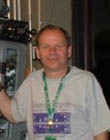|
|
 
|
|
Author
|
Topic: Release Print Sound Track Printing
|
|
|
|
|
|
|
|
|
|
|
Leo Enticknap
Film God

Posts: 7474
From: Loma Linda, CA
Registered: Jul 2000
|
 posted 08-20-2008 05:10 PM
posted 08-20-2008 05:10 PM





That was exactly what occurred to me, too: the edges of the letters in laser-burnt subtitles look a lot rougher than a printed DTS timecode. Presumably the DTS data blocks are large enough for the reader to be able to cope with laser-etched ones. If so, that shows just how resilient DTS is: if the readers can cope with that, I'm sure they can cope with a level of dirt and scratching on a typical release print that would cause Dolby to fail.
MWA are some seriously smart cookies. I had the privilege of visiting their factory in Charlottenburg (a suburb of Berlin) for the training session on a small gauge telecine which the archive I used to work for bought a couple of years ago. Amazingly, they build their line of mag followers, LCD/CCD based telecines and laser film recorders from the ground up in a tiny factory sandwiched between two blocks of flats in a residential side-street off the main road from Berlin city centre to Tegel Airport. Everything form machine tooling the chassis and mechanical film path components to assembling the circuit boards happens there. I've never used their film recording products, but their Flashscan and FlashTransfer telecines are very innovative technologies, delivering true broadcast quality for about 15% of the cost of a Cintel or a Spirit. If they have found a way of directly burning a digital audio track or DTS timecode onto a projection print, this strikes me as precisely the sort of niche market they would try to develop and make cost effective, which the bigger players would give up as being not worth the bother.
| IP: Logged
|
|
|
|
|
|
|
|
|
|
All times are Central (GMT -6:00)
|
|
Powered by Infopop Corporation
UBB.classicTM
6.3.1.2
The Film-Tech Forums are designed for various members related to the cinema industry to express their opinions, viewpoints and testimonials on various products, services and events based upon speculation, personal knowledge and factual information through use, therefore all views represented here allow no liability upon the publishers of this web site and the owners of said views assume no liability for any ill will resulting from these postings. The posts made here are for educational as well as entertainment purposes and as such anyone viewing this portion of the website must accept these views as statements of the author of that opinion
and agrees to release the authors from any and all liability.
|

 Home
Home
 Products
Products
 Store
Store
 Forum
Forum
 Warehouse
Warehouse
 Contact Us
Contact Us




 Printer-friendly view of this topic
Printer-friendly view of this topic












